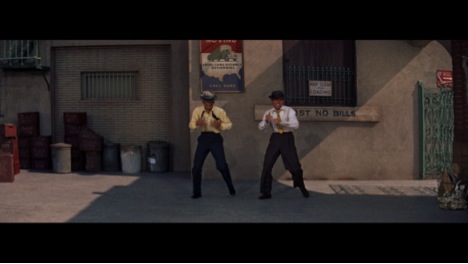[14] Bob Fosse and Tommy Rall: “The Alley Dance” From My Sister Eileen (1955)

Choreography is writing on your feet.
—Bob Fosse2
1
Movie musicals present a dreamy and miraculous view of life, because in them murder and miracles, happiness and sadness are not just moments that come and go, but occasions for the characters to step out of the plot—and dance! Whole city streets of pedestrians and trolley drivers turn into singing, dancing choruses egging the heroes on, and promising them the moon. A quiet, horse-clop-clopping street from a Western becomes rows of tap-dancing cowboys, saloon girls, and bartenders. The cameras dolly down the dusty street following the boys and girls as they waltz and sing love songs. Teenage gangs, cynical carnival roustabouts, soldiers and sailors, gamblers, gangsters, hustlers, barbers, has-been actresses, Shakespearian noblemen, debonair bachelors and spoiled heiresses, trappers, nurses, and mountain men step away from their narrative scripts and start dancing.
what does the dancer
mean? there is no lexicon
or phrasebook for dance
oh, a high perfect scissors
might express exuberance
but it also could
suggest arrogance, so
what if we had said
the high scissors kick’s a thing
and take it for what it’s worth
dancing transports us
somewhere else, to places where
talk stops. wave your arms!
when that’s all that’s left to say
just start kicking up a fuss
2
Bob Fosse’s duet routine has its own vocabulary of slumps and glides, pirouettes and arabesques, hat-tricks and gestural tiptoe sliding, almost a mime. Fosse puts Tommy Rall through his vaudevillian paces. But, in the give and take of challenge and response, Rall, in turn, tests Fosse’s ballet moves. They duel with styles, teasing, copying, taunting, and testing. Fancy jazz dancing versus classical ballet. Here’s the thing, though, you could easily get lost watching this, and imagine two real prospective romancers representing two different conceptions of dance, competing for the same girl, each exploiting his own strength. But, you’d be wrong; Fosse dreamed the whole thing up, put in all the jivey bits as well as the grand jetés. The testing is fictional, a choreography in which Fosse lets both dancers do everything well.
taking the measure
of each other, great dancers
stretch the boundaries
how far, how high, can you
keep everything together
the hats are crucial
like Ginger with Fred Astaire
allowing themselves
to be put through their paces
making the dancers look good
watching dance duets
the critical eye looks out
for discrepancies
Rall, as Jacques d’Amboise recalls
could do triple spins for fun3
3
Only once did Fred Astaire and Gene Kelly dance together in a film and that was their comic tap-dance routine in George Gershwin’s “The Babbitt and the Bromide,” from the movie Ziegfeld Follies (1946).4 The dance is mostly made up of the two of them tapping and doing Astaire-type moves through a tap-dance sampler of sorts, with a lot of broad humor and clowning thrown in. But, without our ever knowing exactly what’s behind it, the implicit narrative anticipates the rivalry between Fosse and Rall above. The two dancers mirror each other through a dazzling array of recognizable maneuvers—tapping, spinning, and kicking in unison until both characters die and the dance moves to just outside the pearly gates. Wonderful to watch two dance “geniuses” working perfectly side by side, step for step, gesture for gesture.
now get hold of this
there is of course a story
how dancing arises
above banality, tells
us the unspoken story
of the truth behind
social formality, set
modes of discourse
dancing tests categories
what’s going on inside us
you can’t dance alone
there’s always you and the thought
of you alongside
here’s a tricky step. do that!
piece of cake! what’s the matter?
Bio: Charles D. Tarlton
